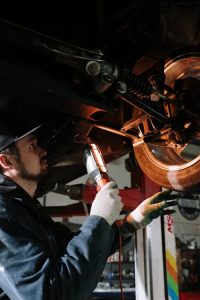800°C: that’s the temperature at the engine outlet that the exhaust manifold is subjected to, so its seal must be perfect for withstanding these extreme combustion temperatures. So let’s take a look at the purpose of the exhaust manifold gasket.
Exhaust Manifold Definition
The exhaust manifold is a cast steel part made up of one pipe per cylinder at the outlet of the exhaust valves, which combine in a common chamber before discharging the burnt gases of combustion to the exhaust pipe.
Expansion parameters partly condition its design: the deformation of the manifold, as it expands, must be limited so as not to affect its sealing.
The specifications
The exhaust manifold seal must have the following qualities:
– Temperature resistance: It must be made of materials resistant to the extreme temperatures of exhaust gases.
– Pressure resistance: The gas pressure at the outlet of the combustion chambers (2 to 3 bars), associated with the temperature and the outlet speed, is very aggressive for the seal.
– Tightness: It must ensure the tightness of the exhaust pipe, but also often that of the intake circuit (an air intake alters the quality of combustion), and often the tightness of the coolant passages.
Description of the exhaust manifold seal
There are two main configurations:
– the one-piece gasket: a single common gasket is inserted between the cylinder head and the manifold, thus sealing the gas outlet ducts.
– the gasket set: each cylinder is equipped with an independent gasket, mainly where the intake manifold is on the same side of the cylinder head, the intake and exhaust ducts alternating. Sometimes the exhaust manifold gasket is the same as the intake.
Exhaust manifold gaskets, which used to be asbestos-free, are now made of metal-plastic gaskets. Their sandwich structure is made up of two outer metal layers encasing an elastomer layer.
Please note: Sealing can be improved with specific temperature-resistant seal pastes such as Loctite “copper” 5920.
Maintenance of the exhaust manifold gasket
It is necessary to replace it under the following conditions:
– When the exhaust manifold is removed, it must be replaced systematically.
– In case of damage, with the following symptoms: exhaust noise on acceleration; blackening due to burnt gases at the leak location.
This operation does not present any particular difficulties, except to :
– meticulously clean the bearing surfaces of the cylinder head and manifold;
– Replace studs and nuts damaged by the temperature (seized or broken);
– Tighten all bolts and nuts progressively, starting from the center of the manifold and working towards the ends.
Exhaust Manifold Gasket Replacement
Associated with a head gasket replacement, it will be present in the lapping kit, which includes all the gaskets necessary to replace the head gasket. You can purchase this kit from independent automotive parts distributors for $80 to $200.
If only the exhaust manifold is removed, the manifold gasket will often only be available at retail through the manufacturer’s network, from $5 to $30.
Read more:
- When Can a Leak Detector Be Used on a Head Gasket?
- How to Change Your Brake Fluid
- How to Verify Braking Noises
- How Do You Restore Car Leather
- How to Repair a Crack on a Dashboard
- 5 Common Causes of Hydraulic Power Steering Failure
- How to Solve a Power Steering Problem
- Is It Worth Buying an Auto Diagnostic Kit
- Automotive Equipment: What Is the Wheel Balancer Used For
- Ever Wonder If Your Vehicle Has a Misalignment Issue?
- Why Perform a Car Diagnostic?
- Increasing the Turbo Pressure
- What Is Ultrasonic Car Injector Cleaning?
- My Car Is Overheating! What Could Be Wrong?




4 thoughts on “Exhaust Manifold Gasket: Maintenance and Replacement”